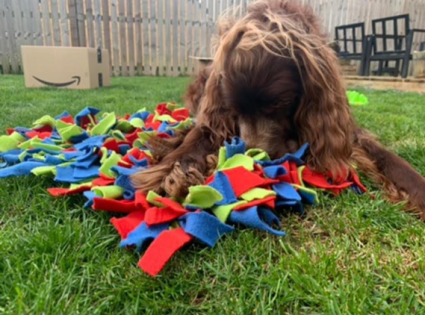Enrichment is so important for dogs and plays an essential role in ensuring both their physical and mental health. Dog enrichment doesn’t need to be complicated and it includes activities that engage and stimulate your dog’s mind, body and senses.
There are so many benefits to enrichment:
- Builds confidence
- Provides safe ways for your dog to express their natural behaviours – sniffing, foraging, digging
- Strengthens their bond with their humans
- Promotes their mental health
- Prevents boredom
- Helps reduce stress and anxiety
- Reduces ‘problem behaviours’ e.g. chewing, barking and things associated with bored and frustrated dogs
- Promotes physical health
- Fun for humans as well as dogs
- Easily tailored to suit your dogs needs – e.g. gives older dogs who may struggle with long walks with entertainment without the physical strain
- Can be done for free (or very cheaply with household items).
Where to start?
Your dog should be getting daily enrichment as part of them living their best lives.
It’s really easy to include quality enrichment as part of your dog’s day.
When considering what enrichment to choose, think about:
- Your dog’s needs – their age, health and dietary needs. For example, an older dog or one with joint issues will be better suited to some snuffling enrichment rather than an agility class
- Your dog’s preferences – try out some different types of activities and see what they prefer
- Trying different options – when you try an enrichment activity with your dog, watch how they take to it (or don’t). If it’s too difficult, they’re uninterested or frustrated – look at alternatives or consider modifying it.
- Enrichment is intended to benefit your dog, not stress and scare them. Some dogs will love nothing more than snuffling in cardboard boxes for treats, whereas a sensitive dog may be terrified by the same box – respect their fears and don’t force them!
We’ll go through lots of different enrichment types in this article to give you lots of ideas.

Food-based
Food based enrichment is one of the easiest things to do with your dog.You can do food enrichment with your dogs daily meals or with their treat allowance for the day.
Even your dogs food bowl can turn into enrichment with things like slow feeders or maze feeders that are very handy with a dog who likes to inhale their food.
Snuffle/scatter feeding is incredibly easy to do and there are so many different options:
- Scatter treats on the grass for them to sniff out and find
- Use towels – a very easy beginner enrichment game. Simply scatter treats across an open towel, then roll the towel up. Encourage your dog to use their nose/paw to unroll the towel and as they do, they will discover their treats.
- Snuffle mats – you can buy these online or make your own. For an easy XL snuffle mat, invest in a hanging planter mat to use as one.
- DIY options such as empty cardboard boxes, egg boxes, toilet roll cardboard tubes – scatter a few treats in, add a little encouragement, and let your dog do the rest.
- Hide and treat games – use empty plastic cups or cones to hide treats under and let your dog go find them. Another great one is to scatter some treats in a muffin tray and cover them with your dog’s tennis balls.
Lickimats provide a wonderful enrichment activity. These are so wonderful because the act of licking releases endorphins in dogs and can help calm them down. These mats are also freezable so once topped you can always pop them in the freezer for an hour to make your dog’s treat last even longer! Some tips for what you can add spread on your lickimat are:
- Any wet food
- Mashed banana with peanut butter (small amount and make sure the peanut butter contains no Xylitol or any other artificial sweeteners)
- Mashed vegetables – cauliflower, sweet potato, peas
- Natural/Greek yogurt (make sure it contains no flavourings and is Xylitol free!)
- Minced meat
- Mashed salmon/tuna
There are also many toys you can buy for food-based enrichment, popular options include:
- Traditional kongs
- Kong wobbler or toppl toys
- Toys that allow you ‘stuff’ treats in for your dog to discover. These can take the form of a ball, a soft toy, a tuff snake, the options are endless!
For dogs who love nothing more than a good chew. There are many options that will allow your dog to safely have a chew and save your slippers…
- Antlers – if your dog is a heavy chewer, they don’t come more robust than an antler. These chews are long-lasting and won’t splinter or stain your upholstery.
- Buffalo horns – another long-lasting chew and it won’t stain your carpets!
- Bones – uncooked bones that will not splinter are an ideal treat for your dog. You should also avoid any pork bones, rib bones or bones smaller than your dog’s mouth as these can splinter and get stuck in your dog’s throat. Some personal favourites include beef knuckle bones, deer leg bones and ostrich bones!
- Yak chews – these are basically a hard bar of milk that your dog will love chomping on. One yak chew can last some dogs weeks, but from personal experience I have seen an extremely determined and greedy Labrador demolish an XL one in a few hours. A good tip with yak chews is that when they get to the stage where they’re quite small (few inches) and you may be worried about your dog choking on them, take it off your dog and stick it in the microwave for 20 seconds to a minute. The yak chew puffs up like giant wotsit – it will stink of cheese when you do this! Then simply leave it to cool before giving it back to your dog again. The texture of it now is basically like a giant crisp so they can finish it without you worrying they might try to eat it in one big lump.
- Wood Chews- natural wood like olive wood or coffee wood chews can be big hits with some dogs, especially if they are partial to a nibble on furniture!
Chews are very much a personal preference for dogs, so you will have some trial and error to see what your dog likes. It is important to ensure your dog is supervised with any chew or toy to make sure they are safe.
Toy-based
As with many aspects of your dog’s life, what exact toys they prefer is always going to be a personal choice. Here are some tips to help keep your dogs play with toys enjoyable, whatever their choice is:
- Rotate toys to prevent boredom
- Encourage their dog behaviours – it’s natural for dogs to want to play tug and shake their toys, let them! And let them win games too!
- Some dogs may destroy some of their toys. If they are a fan of more destructive play with their toys, this is a natural behaviour, so just make sure you supervise them to make sure they aren’t eating any smaller parts. You can also look at other options for ‘destructive play’ like cupboard boxes, egg boxes, etc. Letting dogs dig and tear up a cardboard box you’ve given them is a great game for some dogs, and cheaper than buying new toys every week! Just make sure they’re supervised.
Sensory
Dogs love sensory enrichment, which covers anything that stimulates them using sights, smells and sounds.
Allowing your dog the opportunity to explore either on walks or at home, and activate their senses is vital for them and super easy to do.
Sensory enrichment includes:
- Allowing your dog time to just stop and sniff on a walk! Never underestimate the joys of sniffing for a dog.
- If you want to try something extra you could look into doing fun scent training activities at home, like hiding treats for them to sniff out. Or even look at a scentwork class
- Exploring new walks with your dog, for example a woodland walk or a beach walk, which will give them a whole new sensory feast.
- Giving them toys that have different textures to play with
- Playing music at home.
Physical
Exercise is so important for our dogs (and for us). It is important to tailor your dogs physical activities to take into account their age, any health conditions and their personal likes and dislikes. Physical enrichment can often be paired with other types of enrichment such as sensory and food-based.
There are so many wonderful physical enrichment options to consider:
- Walks in different environments
- Off-lead time at a secure dog field
- Playing with toys with your dog including balls, and tug ropes
- Trick training – this can give excellent mental stimulation for your dog too
- Dog agility – this does not need to be done at a competitive level by any means. You can make DIY agility courses at home or why not try a fun beginners class.
- Flyball – again there are lots of beginner classes out there, remember to keep it fun for your dog.
- Canicross – like running? Well your dog may just be the best running companion you’ve ever had!
Social
Give your dog the opportunity to interact with other dogs and people (provided it is in a safe environment that your dog feels comfortable with). Social enrichment is wonderful as it also gives us humans a fantastic opportunity to spend time with our dogs and really bond with them doing something they enjoy.
Of course you know your dog, and not every social enrichment activity is suitable for all dogs, but here are some ideas to get you started:
- Dog walks with other dogs – this could be going to a local dog park or arranging to meet up with fellow dog owners for a walk
- Visiting dog-friendly places – there are lot of dog friendly venues out there from cafes, pubs, and some shops
- Group classes – you could enroll in a class with your dog. Together you could try anything from puppy training/beginner socialisation classes, agility, scentwork, mantrailing.
- Dog groups – you may have a local dog walking group you could attend, or if you’re into canicross there are often groups you can attend.
- Spend some one on one time with your dog! Play some games together, do some basic training, go and share a pupcup. Enjoy that quality time.



